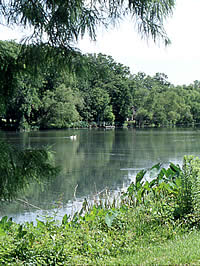
Lake Jackson is an oxbow lake formed
from a cut-off meander of the Brazos River. Plantation
owner Abner Jackson built an artificial island in the
lake on which to entertain his guests. Photo by Norman
Flaigg.
Click images to enlarge
|
|
A golden clump of sugar cane, ready
for harvesting. Sugar cane was a source of great wealth
to nineteenth-century growers such as Abner Jackson,
although production fluctuated according to weather.
Photo courtesy of the Cooperative Extension Service,
Texas A&M University.
|
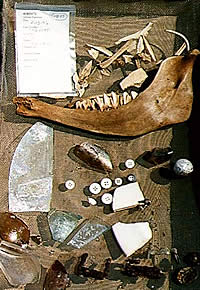
Post-Civil War artifacts found near
the front porch of house, shown drying on a screen after
being washed. The items, including a jawbone of a horse,
bottle glass, and a variety of buttons, were apparently
tossed off the front porch as trash by the occupants
of the house.
|
|
In December, 1867, George W. Jackson killed his
brother John C. during a confrontation at the Lake Jackson
plantation.
|
|
Engraved pocket watch, found during
excavations.
|
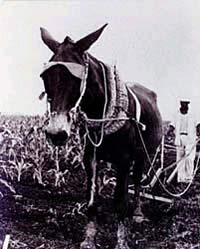
After the emancipation of slaves
in Texas in 1865, sugar growers leased prisoners from
the state prison system to continue operations in the
fields and mills. Photo courtesy of the Brazoria County
Historical Museum.
|
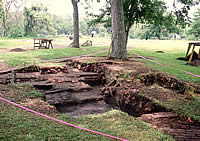
Brick floor of a three-roomed structure
near the main house. Although artifacts and features
indicate domestic use, oral history also suggests it
may have been used at one time as a jail. Photo by Norman
Flaigg.
|
|
Around 1840, wealthy Virginia planter Abner
Jackson brought his wife, Margaret, and their 5 children and
slaves to Brazoria County, Texas, to begin work on their first
plantation, Retrieve. Soon after, they began buying the land
for their second plantation and palatial home, to be nestled
in the bend of a picturesque oxbow lake between the Brazos
River and Oyster Creek. First called the Lake Place, it later
came to be known as the Lake Jackson Plantation.
By all accounts, the Lake Jackson Plantation
was an elegant complex with a columned, colonial style main
house, brick outbuildings, ornamental gardens, and a state-of-the-art
sugar mill. Jackson's eye for detail and quality was described
in a 1926 chronicle by Abner Jackson Strobel, the grandson
of Margaret Strobel Jackson and step-grandson of Abner Jackson:
Major Jackson …opened up the Lake
Jackson Plantation during the period 1842 to 1845. His first
home was made of logs from the nearby forest, mostly elm
and ash. He soon, however, converted every building, cabins,
sugar house and residence into brick made on the plantation,
and stuccoed with cement fully an inch thick, which made
all the buildings look like they were made from solid rock.
The residence was a twelve room two-story
house in the shape of an "I," with six galleries,
and immense brick pillars the entire length of the galleries.
[T]he residence cost, exclusive of slave labor, over twenty-five
thousand dollars completed.
…The sugar house was built of brick,
and the best of machinery for the making of sugar was obtained.
There was an artificial island made in the lake, said to
have cost $10,000 . Fine orchards and gardens were on the
plantations…. Brick walks were laid in the orchard
and garden. The slaves had use of both orchards and gardens.
By 1850, the Lake Jackson plantation had grown
to 3,744 acres. The land was ideal for sugar growing—fertile,
well-watered, and easily cleared. In 1852, Jackson produced
295 hogsheads of sugar with horse-drawn machinery at the Lake
Plantation. Jackons and his partner, James Hamilton, produced
an additional 450 hogsheads at Retrieve. (A hogshead is a
barrel containing roughly 1000 pounds of crystallized sugar.)
In 1857, Margaret Jackson died. Jackson asked
his children and stepson not to claim their share of their
mother's estate because he wanted to continue expansion. The
same year, Jackson purchased the Darrington Plantation for
$116,200. A year later, the sugar mill at the Lake Jackson
plantation was upgraded with the addition of a steam engine
in 1858.
Prosperity and abundance ruled for a brief period.
In 1860, census takers listed Jackson as owning 285 slaves,
making him the second largest slaveowner in the state. His
other holdings were valued at $172,775.
But death and the Civil War brought an end to
the Jackson family's fortune. Abner Jackson died in 1861 deeply
in debt. Probate records indicate that during the Civil War,
John C. Jackson (the eldest son) tried to hold the estate
together and pay off debts when funds were available. When
the war ended, George W. Jackson (Abner's third son, four
years John's junior) returned home. John C. was in control
of the estate and would not turn over any part of it to George.
In September, 1867, a court order enabled George
W. Jackson to gain control of the Lake Jackson plantation,
but conflict remained between the two brothers. In December,
1867, George W. killed his brother John C. during a confrontation
at the Lake Jackson plantation. George W. was never prosecuted
for the murder and he died of tuberculosis on November 7,
1871, in Galveston.
Wm. J. W. Masterson became executor of the estate
of Abner and Margaret Jackson. An attempt to hold the estate
together was made, but documents indicate that debtors were
demanding payment. Subsequently, the estate was sold piece
by piece.
In 1873, William W. Phelps of New York bought
the Jackson Plantation from the estate of George W. Jackson
and his sister, Asenath Jackson Groce, for $20,800. Phelps
sold the property to A.J. Ward and E. D. Dewey for $36,000
that same year.
After the Civil War, Texas adopted a system
of leasing state convicts to private companies and individuals.
Although the system was an effective means of replacing slave
labor, it often resulted in deplorable treatment for the prisoners,
including some at Lake Jackson. In 1871, the state leased
the Huntsville State Prison and all of its prisoners to Ward,
Dewey & Co. of Galveston for a 15-year-period. They in
turn leased convicts to the Lake Jackson Plantation.
An 1874 inspection of the Lake Jackson Plantation
and its prisoners found many of them to be ill and without
medical attention. The inspector found that three convicts
had been severely beaten on their backs; that prisoners were
not being fed well; that a guard had pledged his own credit
to procure meat for the convicts; that convicts had not changed
their clothing for 10 weeks and that some could not cover
their extremities; and that some prisoners slept on bare mattresses
without cover.
In 1875, Edward H. Cunningham and Littleberry
A. Ellis formed a partnership. They contracted with the state
of Texas to lease the entire convict population. Those convicts
they did not use were subleased to other plantations. Their
partnership and use of convict labor was the beginning of
the Imperial Sugar Company of Sugar Land, Texas.
When state prison inspector J.T. Gaines made
his rounds in December, 1876, he reported that three convicts
had died at the Lake Jackson Plantation: one while being punished
in the stocks, one in an escape attempt, and one from natural
causes. Prison records for 1882 list the Darrington Plantation
with 28 convicts and the Lake Jackson Plantation with 36.
The last listing for convicts at Lake Jackson was on November,
1884, with a total of 33.
In 1900, the Lake Jackson Sugar Company took
over the four acres containing the "sugar house, including
the cane mill sheds, gin, saw mill, blacksmith shop."
The Lake Jackson Sugar Company operated only a short time.
The house and mill were badly damaged during the 1900 hurricane
and mill operations ceased.
|
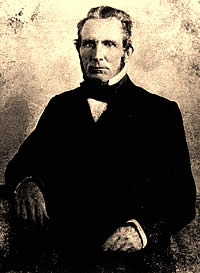
Abner Jackson, owner of three plantations
in Brazoria County. Photograph courtesy of Lake Jackson
Historical Association.
|
|
The residence was a twelve-room, two-story house
in the shape of an "I," with six galleries,
and immense brick pillars the entire length of the galleries.
Abner Jackson Strobel, 1926.
|
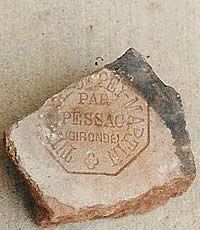
French maker's marks on early brick
from the site. Although both slaves and convicts made
bricks used in construction at the plantation, some
materials apparently were imported.
|
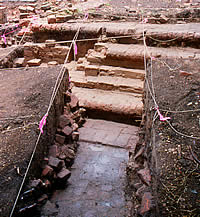
Front porch of the main house after
excavation. Note the rounded bricks of the steps and
curved bricks set into walkway in foreground. High quality
bricks and fine masonry techniques such as these distinguished
slave craftsmanship from later work done by convicts.
Strings with pink flags mark the grid of excavation
units. Photo by Norman Flaigg.
|
|
Death and the Civil War brought an end to the Jackson
family's good fortune. Abner Jackson died in 1861 deeply
in debt.
|
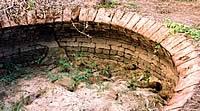
A brick-lined cistern near the main
house. Photo by Sue Turner.
|
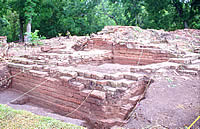
West gallery of the plantation house
following excavation. Strings mark gridlines of excavation
units. Photo by Norman Flaigg.
|
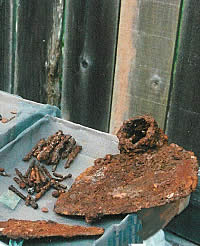
Tools of the laborers. A rusted trowel
and hoe stand out among some of the thousands of excavated
artifacts, poignant reminders of field and construction
labors of the past. (Click to see full image).
|
|
When state prison inspector J.T. Gaines made his
rounds in December, 1876, he reported that three convicts
had died at the Lake Jackson Plantation: one while being
punished in the stocks, one in an escape attempt, and
one from natural causes.
|
|